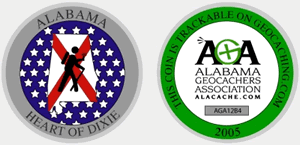The hardware! It’s about time I got to this article. I’ve received a number of inquiries about how I make the PDA work as a geocaching device, and it’s actually pretty simple. I have a knack for over-complicating things, but I have to admit—this one is pretty straightforward.
The gear:
n Dell Axim X30 PDA with Bluetooth
- 1 car charger
- 1 desktop cradle sync/charger
- 3 cases (2 aluminum hard, 1 black leather soft)
n Holux GR-230 Bluetooth GPSr “puck”
- 1 charger A/C + usb cigarette lighter charger port
n 1 Apple iPod Touch 2nd Generation (optional)
The Axim:
PROs:

n It’s cheap! When I first bought mine in 2004, it cost me thereabouts of $200 +/-. Now a solid used unit will run $50-90 depending on condition and accessories on eBay.
n Replaceable battery! There’s essentially 2 types of Li-ion batteries for the Axim—900mAh, which sits flush with the PDA’s back and 1400mAh (the extended battery) which sits about ¼ inch out from the back of the PDA. Ironically enough, each cost roughly the same on eBay at $10 each and they typically last 3-5 years depending on use and care.

n SD card, wi-fi, bluetooth, internal microphone, external speaker, runs all Windows Mobile 2003 software—syncs with Outlook or a server for contacts, calendar, email and files—infared port for sharing data, printing or working as a remote control.. etc. You get the idea. This little guy does quite a bit.
n It’s light! With the 900mAh battery installed, it weighs less than my cellphone (handy if dropped—less inertia = less chance of damage)
CONS:

n It’s not ruggedized. It is a PDA, after all. To get around this, I’ve procured two aluminum cases (one for the 900mAh battery size and another for the extended battery) with neoprene cushioning.
n Battery life. With the 1400mAh battery, battery life is approximately 4 hours without any form of recharge. The 900mAh will yield about 2 hours and change depending on usage and battery care. To mitigate battery drain as an issue, I travel with the 900mAh as a backup battery and charge the device between caches when driving.
n It’s a 2-part unit. To work as a geocaching platform, the Dell Axim must connect with a GPS receiver. This can be done through a physical cable but that’s just not very conducive to good caching. Instead I connect to a Holux-manufactured GPSr “puck”. And yes, as the name suggests.. it looks like a hockey puck.
The Holux GR-230 GPSr:
There's really not much to say about this device, and certainly not enough to do a pro/con writeup. It's operation is mind-numbingly simple. Get this—you turn it on. Oh, yeah that's really all there is to it. Once you turn it on, you connect to it via bluetooth on the PDA and viola, you've got a GPS feed. It's durable, it comes with a non-slip pad on the bottom to keep it anchored to whatever you set it down on (no adhesive) and the battery life is extremely long. I got 8 hours out of it once, and it was still going strong without a recharge.
It does come with a port for an antenna if you'd like to plug it into a vehicle without a clear view of the sky above, and it's chargeable both through DC (USB cable to a cigarette lighter charger) or A/C (USB cable to a regular A/C socket plug adapter).
The iPod Touch:

I've got to say, this is one cool app for iPhone users but it's less than helpful for iPod Touch users--especially those who already have an all-in-one caching platform on the PDA. That said, it's user and fat-finger friendly so I've caught myself using it from time to time. If I could use the iPod Touch the same way I use the PDA, I'd retire the PDA as the iPod Touch has far more features and capabilities than the PDA and a much longer battery life.
In the field I've caught myself shutting down the PDA when I get to the cache location, and whipping out the iPod from time to time to get the cache hint and/or clues to the cache itself. I do this because it preserves battery on the PDA and its easy to "fat finger" your way through the cache details. The PDA has the exact same data, but it takes me just a little bit longer to get to it.
That’s about it! As I’ve said before, it’s pretty straightforward. If you have any questions regarding your setup, don’t hesitate to ask.
Help us out by clicking the “Follow us” link in the right toolbar of the blog!














 So for the third time, we’re reinventing our little family team with a new name and improved technology. Always a stickler for making old dogs learn new tricks, I’ve decided to blow the dust off of the old Axim X30 and turn it back on again. In digging out the old trusty Axim and blowing the dust off of it’s various components (literally), I began the BDA (battle damage assessment for you non-military types).
So for the third time, we’re reinventing our little family team with a new name and improved technology. Always a stickler for making old dogs learn new tricks, I’ve decided to blow the dust off of the old Axim X30 and turn it back on again. In digging out the old trusty Axim and blowing the dust off of it’s various components (literally), I began the BDA (battle damage assessment for you non-military types).


